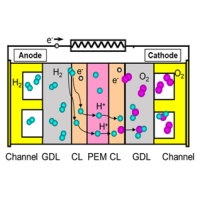Clarification of Water Transport and the Electrochemical Characteristics in Polymer Electrolyte Fuel Cell
Purpose
 |
Fuel gas (hydrogen gas) and oxidant gas (air) are supplied to a polymer electrolyte fuel cell (PEFC). Condensation may occur on the cathode side, because the vapor is supersaturated by the fuel cell reactions. When condensed water exists in the gas diffusion layer (GDL), gas diffusion is depressed as flooding. Furthermore, a larger amount of water in the gas channels may prevent the gas supply in the channel. Fuel-cell performance decreases because oxygen is prevented from reaching the cathode reaction site. The generated water must be appropriately supplied to the proton exchange membrane (PEM) for proton conduction. Hence, water management is significantly important for PEFC performance, and clarification of the water-transport mechanisms between the PEM, GDL, and gas channels are of great concern.
In this study, neutron radiography has been employed for measuring water distribution under the PEFC operation. The water distribution are compared with the fuel cell performances and the model has been developed.
Research content
Neutron radiography is based on the principle that the neutron attenuation
is different in each material. The mass attenuation coefficient of water
is much higher than many metals such as iron and aluminum. Hence, water
accumulation in the PEFC made of metals can be confirmed from the brightness
distribution in the radio-graph. Right figure represents a neutron radiograph
after the PEFC operation. Water accumulation at the cathode channel can
be clearly observed. Applying a image processing method, time-series of
water accumulation can be obtained.
In order to evaluate the PEFC performances, electrochemical impedance spectroscopy
(EIS) measurements are simultaneously carried out with the neutron radiography.
From the results, relation between the water distributions and the electrochemical
characteristics are compared, and the models associating with the mass
transport and the overpotentials are evaluated. These models are applied
to the numerical analysis.
Publications
H. Murakawa, S. Sakihara, K. Sugimoto, H. Asano, D. Ito, Y. Saito
Simultaneous Measurements of Water Distribution and Electrochemical Characteristics
in Polymer Electrolyte Fuel Cell, Materials Research Proceedings 15 (2020)
pp. 268-273. https://doi.org/10.21741/9781644900574-42
H. Murakawa, K. Sugimoto, M. Sawada, M. Nishizaki, H. Asano, N. Takenaka, Y. Saito
Study of water transport phenomena in polymer electrolyte fuel cells in
the through-plane direction, Multiphase Science and Technology 27(2-4)
(2015), pp.117-132. https://doi.org/10.1615/MultScienTechn.v27.i2-4.20
H. Murakawa, K. Sugimoto, N. Kitamura, M. Sawada, H. Asano, N. Takenaka, Y. Saito
Visualization of water accumulation process in polymer electrolyte fuel
cell using neutron radiography, Physics Procedia 69 (2015), pp.607-611.
https://doi.org/10.1016/j.phpro.2015.07.086
H. Murakawa, K. Sugimoto, N. Kitamura, H. Asano, N. Takenaka, Y. Saito
Visualization and Measurement of Water Distribution in Through-Plane Direction of Polymer Electrolyte Fuel Cell during Start-Up by Using Neutron Radiography, Journal of Flow Control, Measurement & Visualization 3(3) (2015), pp.122-133. https://doi.org/10.4236/jfcmv.2015.33012
M. Sawada, M. Nishizaki, H. Murakawa, K. Sugimoto, H. Asano, N. Takenaka, Y. Saito, D. Ito
Visualization of water distribution in an operating PEFC in the through-plane
direction, Proc. of International Conference on Power Engineering-15 (2015)
#ICOPE-15-1041. https://doi.org/10.1299/jsmeicope.2015.12._ICOPE-15-_28
Back